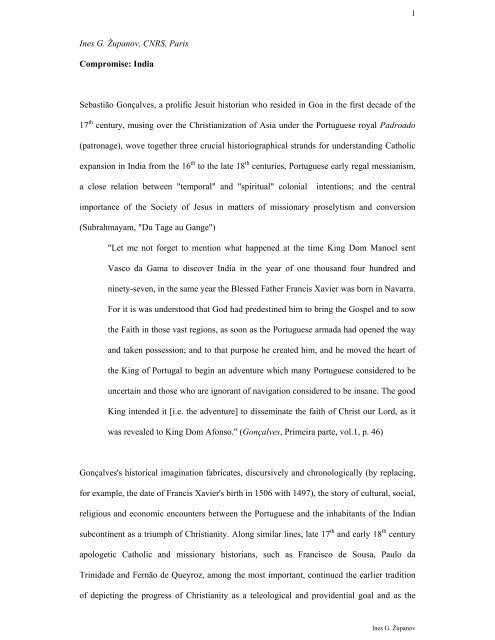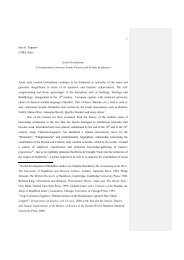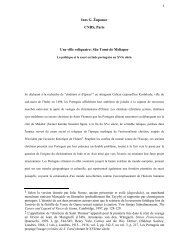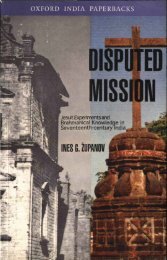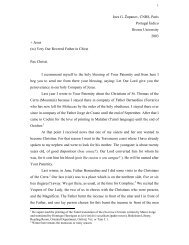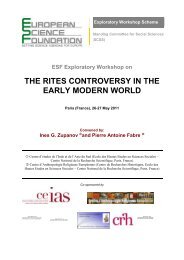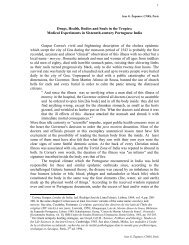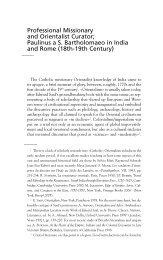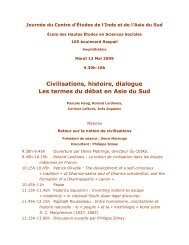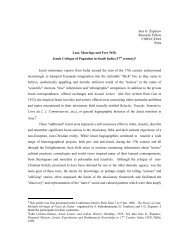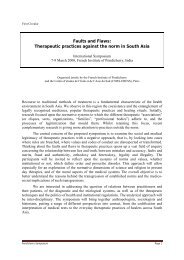Ines G. Županov, CNRS, Paris Compromise: India Sebastião ...
Ines G. Županov, CNRS, Paris Compromise: India Sebastião ...
Ines G. Županov, CNRS, Paris Compromise: India Sebastião ...
Create successful ePaper yourself
Turn your PDF publications into a flip-book with our unique Google optimized e-Paper software.
1<br />
<strong>Ines</strong> G. <strong>Županov</strong>, <strong>CNRS</strong>, <strong>Paris</strong><br />
<strong>Compromise</strong>: <strong>India</strong><br />
<strong>Sebastião</strong> Gonçalves, a prolific Jesuit historian who resided in Goa in the first decade of the<br />
17 th century, musing over the Christianization of Asia under the Portuguese royal Padroado<br />
(patronage), wove together three crucial historiographical strands for understanding Catholic<br />
expansion in <strong>India</strong> from the 16 th to the late 18 th centuries, Portuguese early regal messianism,<br />
a close relation between "temporal" and "spiritual" colonial intentions; and the central<br />
importance of the Society of Jesus in matters of missionary proselytism and conversion<br />
(Subrahmayam, "Du Tage au Gange")<br />
"Let me not forget to mention what happened at the time King Dom Manoel sent<br />
Vasco da Gama to discover <strong>India</strong> in the year of one thousand four hundred and<br />
ninety-seven, in the same year the Blessed Father Francis Xavier was born in Navarra.<br />
For it is was understood that God had predestined him to bring the Gospel and to sow<br />
the Faith in those vast regions, as soon as the Portuguese armada had opened the way<br />
and taken possession; and to that purpose he created him, and he moved the heart of<br />
the King of Portugal to begin an adventure which many Portuguese considered to be<br />
uncertain and those who are ignorant of navigation considered to be insane. The good<br />
King intended it [i.e. the adventure] to disseminate the faith of Christ our Lord, as it<br />
was revealed to King Dom Afonso." (Gonçalves, Primeira parte, vol.1, p. 46)<br />
Gonçalves's historical imagination fabricates, discursively and chronologically (by replacing,<br />
for example, the date of Francis Xavier's birth in 1506 with 1497), the story of cultural, social,<br />
religious and economic encounters between the Portuguese and the inhabitants of the <strong>India</strong>n<br />
subcontinent as a triumph of Christianity. Along similar lines, late 17 th and early 18 th century<br />
apologetic Catholic and missionary historians, such as Francisco de Sousa, Paulo da<br />
Trinidade and Fernão de Queyroz, among the most important, continued the earlier tradition<br />
of depicting the progress of Christianity as a teleological and providential goal and as the<br />
<strong>Ines</strong> G. <strong>Županov</strong>
2<br />
result of the Portuguese presence in <strong>India</strong> and Asia in general. By digging beneath the fertile<br />
soil of such historical generalizations and outright epistemological projects, mostly peddled<br />
by the Jesuit missionary intelligentia, a more complex set of scenarios is unearthed in the<br />
immense expanse of <strong>India</strong>n cultural and religious encounters. One of the decisive factors<br />
throughout this period was Portuguese and Spanish (from 1580 to 1640) royal policy towards<br />
missionary activity, with alternating zeal or disinterest, which was often translated in terms of<br />
generous or nominal economic support (Gruzinski, "Les mondes mêlés). Translating into<br />
practice the royal desires and ordonnances depended on the local government in Goa, or in<br />
other Portuguese enclaves, which had the means to speed up or delay decisions indefinitely.<br />
The tension between the center and periphery was also reflected in the workings of, on the<br />
one hand, the ecclesiastical insitutions under direct royal temporal jurisdiction and, on the<br />
other hand, of the spiritual, but indirect and often weak, jurisdiction of the Papacy. Open or<br />
surreptitious rivalries between religious orders, between missionaries and diocesan priests,<br />
between European and non-European priests, between Portuguese missionaries and Italian<br />
missionaries and so on, complicated the situation. The list of possible and effective divisions<br />
is not only long but also unstable, as the alliances were forged and unmade with remarkable<br />
speed and defied all predictability. The colonial chessboard on which various actors strived to<br />
pose and position themselves - from "official" Portuguese expatriates (reinões) to freelance<br />
merchants and outlaws (casados, chatins, degredados) whose lifestyle and progeny were<br />
rapidly indigenized, and to "New Christians" in search of a safe haven from intolerant<br />
metropolitan policies, as well as "old" St Thomas Christians encountered in Malabar - was<br />
further enlaged by mushrooming convert communities. With the establishment of the<br />
Congregation of the Propagation of Faith, in 1622, by the Papacy and the gradual erosion of<br />
the Portuguese royal padroado on <strong>India</strong>n territory, new missionary enterprises came into<br />
being and new actors came to play important roles, such as Descalced Carmelites and French<br />
missionaries from the Société des Missions- Étrangères (Launay, Histoire générale). The<br />
formation of an <strong>India</strong>n clergy received a decisive fillip as well. With the Dutch, English and<br />
French intruding politically, economically and militarily in the region, with more or less<br />
<strong>Ines</strong> G. <strong>Županov</strong>
3<br />
defined "spiritual" goals, the Christianization of <strong>India</strong> haltingly separated into different<br />
directions. The "liberalisation" of the <strong>India</strong>n Christian market and the diversification of the<br />
supply of religious specialists multiplied in many ways the areas of friction between European<br />
actors and provided a space of creative (spiritual, economic and cultural) freedom for the<br />
<strong>India</strong>n Christian communities.<br />
Early Portuguese Expansion Overseas: Messianism, Papal Bulls and Patronage<br />
Weakness or authoritarianism, or both, are evoked as explanations for regal<br />
messianism in early modern Europe. In the early16 th century, the Portuguese king, Dom<br />
Manuel was not alone in dreaming of the Fifth Empire (quinto império), conceived as both a<br />
colonial empire and a Christian utopia, a new beginning under the banner of the dynasty of<br />
Avis. Portuguese maritime "discoveries" and progressive expansion along the West African<br />
Coast were conceived already in the middle of the 15 th century by Gomes Eanes de Zurara,<br />
Henry the Navigator's apologetic chronicler, as yet another utopian project. Besides gold and<br />
slave hunting, it was nothing less than a way to reach Prester John, the long-lost mythical<br />
Christian king of the East, inhabiting vaguely in European minds the country called Ethiopia,<br />
and to enroll him for the final annihilation of Islam and the reconquest of Jerusalem. What<br />
Zurara, on the other hand, was not even able to imagine was the fact that at the very moment<br />
of his writing, Islam, or rather, Arab and Persian traders, had already brought into being, and<br />
without the important work of proselytism, a whole "federation" of Muslim states and<br />
communities in Africa and Asia. All along the East African Coast, the first Portuguese<br />
expeditions, that of Vasco da Gama in 1498 and of his successor Pedro Álvares Cabral in<br />
1500, discovered to their surprise and dismay that the major commercial centers such as<br />
Sofala, Mozambique, Kilwa, Mombasa, Malindi and Mogadiscio were administered by<br />
Muslim governors. Moreover, even in <strong>India</strong> in spite of da Gama's initial mistaken discovery<br />
of the lost Christians of the legend, maritime commerce in Calicut, Cochin, Cannanore,<br />
Quilon/Kollam, and many other places was solidly in hands of Islamicized communities,<br />
<strong>Ines</strong> G. <strong>Županov</strong>
4<br />
indigenous and foreign. The crusading zeal of the Portuguese against infidels was thus<br />
nurtured in the <strong>India</strong>n Ocean in combination with the mercantile desire of the state to capture<br />
and monopolize the spice trade with Europe.<br />
The early Portuguese activities in the <strong>India</strong>n Ocean, therefore, followed the behavior<br />
pattern already rehearsed during their violent capture and foundation of presídios in Marocco.<br />
Thus, in an act of vengance after the conquest of Goa (1510), Afonso de Albuquerque ordered<br />
the massacre of all Muslims - except women, whom he planned to baptize and marry off to<br />
Portuguese settlers. Christianity was understood by these early military commanders more as<br />
an invigorating and unifying martial ideology than as a system of ethical rules and<br />
commandments. The confusion of religious and political goals was neither new nor a passing<br />
affair and although the distinction between them became paradoxically both less obvious and<br />
more refined, in the decades and centuries to come, the basic contradictions remained intact.<br />
Besides the inherited spirit of the reconquista, Dom Manuel nurtutred a brand of<br />
personal Messianisam. Had Providence wanted to fulfill Dom Manuel's dreams, the<br />
Christianization of Asia, one might suppose, would have worked itself out naturally with the<br />
help of the Prester John's Christians, which is at least partly the reason why proselyte<br />
missionary activity before John III's reign never gained impetus. Another important reason<br />
lies in the fact that the Papacy and the Church in general showed little initiative, except<br />
rhetorically, in such activity. From the 1440s, Eugene IV and his successors issued various<br />
bulls regulating the religious side of the future travels of discovery and conquests by Henry<br />
the Navigator (Witte, "Les bulles pontificales"). As accorded by the Papacy, Portuguese<br />
territorial and political sovereignty over the overseas conquests also implied patronage of the<br />
missions and churches within its geographical boundaries. With the power to appoint<br />
archbishops and bishops, and to distribute ecclesiastical benefices at his own will, Dom<br />
Manuel, and later John III, tried - without fully succeeding - to centralize and control all<br />
aspects of Portugal's overseas expansion. Royal privileges and prerogatives implicit in the<br />
padroado system were many, such as syphoning off church revenues and tithes, or creating a<br />
network of dependents from among the appointed benefice holders ; but there were also<br />
<strong>Ines</strong> G. <strong>Županov</strong>
5<br />
certain important and costly obligations concerning the creation of missions, new bishoprics,<br />
convents and sanctuaries. However, the overseas ecclesiastical institutions of the Portuguese,<br />
reinforced by direct state intervention, should not be equated, in spite of circumstantial<br />
convergence, with missionary activity. In fact, they were often at odds, especially from the<br />
second part of the 16th century when the transnational Society of Jesus "invented", captured<br />
and monopolized the missionary field in Asia (O'Malley, The First Jesuits).<br />
Goa: The Center of Missionary Activity in Asia<br />
All Portuguese expeditions in the <strong>India</strong>n Ocean were accompanied by one or more<br />
official chaplains: members of religious orders or secular priests. On board ships, they acted<br />
as spiritual counselors and nurses and were also the first to plant crosses and to bless padrões<br />
(memorial stones) on the "virgin" land of discovery. The next step in religious implantation<br />
was the foundation of churches and chapels, usually built literally on or of the debris of<br />
mosques and Hindu temples. In the years to come, especially by the end of the 16 th and in the<br />
17 th century, larger and more sumptuous religious edifices were erected, and official papal<br />
recognition followed through grants of ecclesiastical benefices.<br />
Thus, the chapel of St. Catherine in Goa, initially a mud and palm leaf construction<br />
built by Albuquerque shortly after the conquest, in 1510, was replaced in the following<br />
decades by a larger stone building and became in 1534 the cathedral of the first Asian<br />
diocese, which consisted of a vast territory from the Cape of Good Hope to China. Before<br />
March 1539, when the first bishop of Goa, Juan de Albuquerque, a Franciscan Recollect (or<br />
Capucho), inaugurated the diocese, small parties of his co-religionists and some diocesan<br />
priests were already beginning the work of conversion, very closely following the commercial<br />
and political routes and networks of the Portuguese (Meersman, The Ancient Franciscan<br />
Provinces).<br />
The contemporary Portuguese dilemma concerning the overseas empire, contrasting<br />
free trade and royal monopoly and dirigisme, found an echo or simple parallelism among<br />
<strong>Ines</strong> G. <strong>Županov</strong>
6<br />
religious specialists (Subrahmanyam, Portuguese Empire). In addition, the overlapping<br />
jurisdictions of the royal padroado and of the papacy steadily grew, and the question of the<br />
center of ecclesiastical authority was therefore always open and disputable. Moreover, in spite<br />
of a call for the creation of a new Christian Goa, a kind of utopian dream starting with Afonso<br />
de Albuquerque's marriage arrangements for the Portuguese settlers (casados) and the<br />
Christianization of their native spouses, the proselytising effort was mitigated by practical<br />
constraints, such as the fact that Hindu and Muslim merchants brought business into the city<br />
and facilitated diplomatic and commercial ties with the Deccan hinterland. Nevertheless,<br />
conversion on the Ilhas, the five islands of the original conquest of Goa, and on the later<br />
additions of Bardez and Salcete after 1543, accelerated, especially among lower and poorer<br />
agricultural classes, stimulated by well-orchestrated public rituals, such as solemn mass and<br />
baptism celebrations (D'Costa, Christianization of the Goa Island). It was through<br />
"charitable" institutions, such as the confraternity of Misericórdia, that the new Christian<br />
communities, including that of the Portuguese settlers with their local spouses and slaves,<br />
came under firmer ecclesiastical control. The exercise of Christian charity facilitated<br />
communal integration, particularly in far-removed territories where family, class or regional<br />
ties were often tenuous because of the vagaries of commercial and military enterprises (Sá,<br />
Quando o rico se faz pobre).It was not before 1541 that the confraternity of the Holy Faith<br />
was established for the non-European Christians including a seminary for the education of the<br />
indigenous clergy. The finances for this enterprise were raised by taxing the non-Christians<br />
and appropriating revenues formerly associated with Hindu places of worship, which were on<br />
the way to being massively destroyed throughout the islands of Goa (Wicki, Documenta<br />
Indica, vol. 1, pp. 756-770).<br />
The intensification of missionary efforts after 1542 consisted mostly in the branching<br />
out and refinement of former trends which had been set in motion shortly before the Jesuit<br />
arrival and which followed the moods of both metropolitan and local politics. Even if Francis<br />
Xavier did write to João III demanding that the Inquisition be established, the first "New<br />
Christian" (a Christian of Jewish origin) had been burnt in Goa in 1539. The hardening of<br />
<strong>Ines</strong> G. <strong>Županov</strong>
7<br />
heart against the inhabitants of Jewish descent, provoked partly by local circumstances - the<br />
presence of, and rivalry with, Jewish merchants along the Malabar Coast and in Ormuz - was<br />
also part and parcel of a new Joanine policy in the second part of the 16th century when<br />
Spanish influence began to play a considerable role in Portuguese religious enterprise. During<br />
the Regency under the dowager queen Catarina and Infante-Cardinal Henrique, from 1557<br />
until <strong>Sebastião</strong>'s direct rule sometime before 1570, the royal house of Portugal endeavored to<br />
modify and efface its "spice merchant" image and began to emulate the Habsbourg ideals of<br />
agrarian based aristocracy, always ready to sacrifice commercial profits for the display of<br />
noble, pious actions and belated chivalry.<br />
In Asia, moving within and along the frontiers of the expanding social, political and<br />
economic world of the Portuguese, the missionaries, Jesuits in particular, were perfect<br />
Doppelgänger of the other prominent social group: the merchants. They were, in short,<br />
spiritual entrepreneurs who endeavored to open new markets and, as a general rule, the farther<br />
from the center the more open they were to structures, modes and forms of belief and<br />
sociability of the peoples with whom they came in contact. Inversely, the closer to the center,<br />
Goa in the case of the <strong>India</strong>n missionary field, religious orders endeavored to monopolize all<br />
activities regarding ecclesiastical and "spiritual" enterprises and thus inaugurated long and<br />
complicated rivalries between European colonial actors, both lay and religious. The<br />
conversion methods of the various missionary orders, on the other hand, remained the same: a<br />
combination of incentives (solemn baptism, acquisition of property and titles) and threats to<br />
use symbolic and "real" violence (eviction from the land, prohibition to use and display local<br />
marks of prestige such as the palanquin, etc.) (Thekkedath, History of Christianity in <strong>India</strong>).<br />
Estheticization of Religious Propaganda, Inquisition and the Indigenization<br />
Religious feasts and processions in Goa and throughout the Asian strongholds of the<br />
Portuguese were social performances of great symbolic and ideological display geared at<br />
strengthening communal solidarity, while at the same time opening a "reflexive" space and<br />
<strong>Ines</strong> G. <strong>Županov</strong>
8<br />
encouraging the integration of new social actors. It was often following such ostentatious<br />
events that individuals or groups, Christian and non-Christian, rushed to religious institutions<br />
and asked for spiritual instruction, confession or baptism. After 1575, the magnificent adult<br />
baptism scenes, mostly organized by the Jesuits, were no more in fashion because almost all<br />
of the village communities on the Goan islands were Christian. Nevertheless, Jesuits still<br />
noted about 500 conversions a year until the end of the century and an even larger number for<br />
the first part of the 17th century (Guerreiro, Relação annual, vol. 1, p. 4). The Goan religious<br />
calendar hardly became less impressive with the decline of solemn baptism, for numerous<br />
festivities continued to entertain, amuse, edify and in some cases terrify the population.<br />
Various processions and acts of public devotion during the Holy Week presented the most<br />
stunning spectacles in which penitents performed flagellation and other mortifications (Rego,<br />
História das Missões, vol. 1, pp. 495-496).<br />
The growing number of Christians and the simultaneous resistance to conversion<br />
posed a new problem: Were these conversions sincere or only a shield for secret "pagan"<br />
practices? The ecclesiastical hierarchy, already casting a menacing shadow over the families<br />
of cristãos novos settled in Cochin and Goa, proved to be lastingly doubtful of Hindu<br />
converts, defining them as a second-class Christians and often refusing to ordain even<br />
mestiços (born to Portuguese fathers) (Tavim, "From Setúbal to the Sublime Porte"). The<br />
third provincial council of Goa (1585) had decreed, moreover, that the adult converts could<br />
receive ordination only fifteen years after baptism and were to be at least thirty years of age.<br />
The fifth provincial council (1606) added a local "caste" flavor to these highly selective<br />
restrictions: only Brahmans and other "noble" castes were to be admitted to the priesthood<br />
(Cunha Rivara, Archivo Portuguez Oriental, fasc. 4). Indigenous diocesan priests employed<br />
in Goan parishes rarely acquired ecclesiastical benefices, those being reserved for the<br />
Portuguese. Nevertheless, these "parish jobs" were much coveted and, in the 17th century,<br />
<strong>India</strong>n diocesan priests resented the presence of religious orders which still retained in their<br />
hands nearly two thirds of the parishes (Melo, The Recruitement). The religious orders were<br />
generally more sympathetic to their new converts, but very few natives or mestiços were<br />
<strong>Ines</strong> G. <strong>Županov</strong>
9<br />
permitted to join any religious order before the second half of the 18th century (Boxer, The<br />
Church Militant, pp. 12-14). The same status was also reserved for Portuguese of Jewish<br />
ancestry. After 1622, the newly established Sacred Congregation for the Propagation of<br />
Faith (often abbreviated as Propaganda Fide) in Rome worked actively to undermine the<br />
Portuguese padroado, considered as ineffective, by stimulating the formation of the local<br />
clergy and even conferring higher ecclesiastical benefices on Goan priests (Metzler, Sacrae<br />
Congregationis). The 17 th -century case of Mattheus de Castro, a Goan Brahman, is often<br />
taken as an example, although his mandate as a bishop continued to be marred by opposition<br />
from the Goan ecclesiastical hierarchy (Ghesquière, Mathieu de Castro). It was not until the<br />
last decades of the 17th century that the Goan diocesan priests, headed by Joseph Vaz, pulled<br />
their ranks together and founded their own congregation - Oratório do Santa Cruz dos<br />
Milagres - which was finally approved in 1686 by the pope and the king of Portugal under the<br />
rules of the Oratory of St. Phillip Neri - and all this in spite of the opposition of the Goan<br />
archbishop (Nunes, Documentação). A year later, Goan Oratorians started their own Catholic<br />
mission in Sri Lanka (Flores, "Um Curto Historia de Ceylan")<br />
Not all archbishops of Goa were adamantly against indigenous clergy. A famous<br />
Augustinian archbishop, Dom Aleixo de Menezes (1595-1609) appointed <strong>India</strong>n priests to<br />
various parishes in Goa, Kanara and the Bassein region. His ordinations en masse of St<br />
Thomas Christians during the Synod of Udayamperur (Diamper) is another sign of his policy<br />
of "indigenization" of ecclesiastical offices stimulated by similar Jesuit success stories in<br />
Japan. There was no consistent policy, however, concerning the recruitment of indigenous<br />
clergy and the prelate who replaced Menezes, Christóvão de Sá e Lisboa (1616-22), swore on<br />
the missal never to ordain any indigenous priest. What he was tacitly denouncing was also the<br />
incessant papal efforts to circumvent the Portuguese padroado by encouraging missions<br />
outside the direct control of the Estado da Índia in the midst of "heathen" and "infidel"<br />
kingdoms (Rubiés, Joan-Pau "The Jesuit Discovery of Hinduism". The jurisdictional<br />
muddle arising from this struggle marked the whole of the 17th and the 18th centuries, until<br />
the Marquis of Pombal made sure that the Goan clergy officially achieved equality vis-à-vis<br />
<strong>Ines</strong> G. <strong>Županov</strong>
10<br />
their European counterparts. Another target of Pombal's reforms was the Inquisition, which he<br />
simply abolished (1774), although after his own fall from power it was briefly resuscitated<br />
until 1820.<br />
Often associated with the second, "Spanish" phase of João III's reign, the Santo<br />
Ofício, the Inquistion, found its way to Goa only in 1560 during the Regency of the dowager<br />
queen Catarina and thrived for almost two and a half centuries, notwithstanding waves of<br />
opposition from the secular governments and even from the clergy and archbishops.<br />
Conceived as a royal weapon of centralization against the particular interests of just about<br />
everybody else in the kingdom, the implantation of the Inquisition in Goa - its jurisdiction<br />
often overlapping with that of the secular authorities - provoked endless disputes. This<br />
institution eventually grew to become a state within a state with elaborate bureaucracies and<br />
clients (Baião, A Inquisição). In spite of its busy working schedule in Goa, financed by the<br />
local government, in setting up trials - from 1562 to 1774 there were 16,202 registered court<br />
cases -, and organizing awe-inspiring autos-da-fé, only about two hundred people were<br />
actually burnt at the stake. More important was the extent to which the tribunal confiscated<br />
the property and riches of the local New Christian families in order to feed its own machine<br />
(Amiel, "Les archives de l'Inquisition).<br />
Missionary Frontiers Beyond Goa: The St Thomas Christians and the Parava Converts<br />
From the middle of the sixteenth century, the Portuguese factory-settlements that<br />
dotted the west and the east coasts of <strong>India</strong>, South-East Asia and, later on, Japan and China,<br />
endeavored to organize their own religious life in imitation of the Goan Catholic<br />
effervescence. Most of them had rather limited and short-lived success due to political,<br />
economic and social conditions, while a few managed to survive long into the modern period.<br />
Around the time when Goa was elevated to the rank of archbishopric (1558), two dioceses<br />
were created - Cochin and Melaka - followed by Macau (1576), Funai in Japan (1588),<br />
Angamale on the Malabar coast (1594; it became an archbishopric in 1608) and Mylapore<br />
<strong>Ines</strong> G. <strong>Županov</strong>
11<br />
(1600). In addition to being in charge of the diocesan priests, under the jurisdiction of the<br />
bishops, the Portuguese padroado was also obliged to provide for the upkeep of the<br />
missionaries belonging to different monastic orders. Franciscans, Dominicans, Jesuits and<br />
Augustinians established their missions, colleges, monasteries and other institutions before<br />
the end of the sixteenth century. A second wave of missionary orders century directly<br />
financed by and responsible to the Propaganda Fide - Carmelites, Capuchins, Italian<br />
Oratorians and Theatines - arrived in the seventeenth. Although in theory they were sent to<br />
"help out" the padroado and were to be employed in the fields still not covered by the<br />
missionary staff, newcomers were often seen as intruders and treated as such by the<br />
Portuguese ecclesiastical and colonial administration.<br />
The "discovery" of St Thomas or Syrian Christians on the Malabar coast was<br />
considered to be providential by Pedro Àlvares Cabral and his successors engaged in Asian<br />
pepper empire-building. Due to its corporate control of commercial enterprises, its tradition of<br />
martial prowess and its “noble” or “purity conscious” lifestyle, this Christian group (estimated<br />
to have numbered between 80 000 and 200 000 in the course of the century) held a privileged<br />
position in the social and political fabric of sixteenth-century Kerala, and thus opened the way<br />
for the Portuguese traders to profit from local market opportunities. At the same time St.<br />
Thomas or Syrian Christians accepted Portuguese patronage in expectation of an<br />
enhancement of their own economic and symbolic prestige. However, the centralizing nature<br />
of the political and colonial intentions of the Estado da Índia was soon in conflict with the<br />
existing, segmentary power relations in Kerala, which had previously left to St Thomas<br />
Christians a high degree of autonomy. It was through religious patronage that the Portuguese<br />
endeavored to gain control of this <strong>India</strong>n community which claimed as its founder one of<br />
Christ's disciples, St Thomas, and had maintained ecclesiastical connections, from at least the<br />
4th century, with the independent West Asian churches. These ancient religious ties came to<br />
be branded by the Portuguese ecclesiastical hierarchy as illegitimate since the doctrine of the<br />
Syrian patriarchs was known to be based on Nestorian teaching and was, therefore, "heretic".<br />
Furthermore, according to the regulation of the padroado, the appointment of the bishops was<br />
<strong>Ines</strong> G. <strong>Županov</strong>
12<br />
the prerogative of the Portuguese king and the pope and thus, all "foreign" ecclesiastical<br />
officials sent by the West Asian Patriarchs were potentially seen as transgressors. During the<br />
first half of the sixteenth century, Portuguese relations with St Thomas Christians appear to<br />
have been relatively harmonious, primarily due to the lack of European missionaries<br />
(Mundadan, History of Christianity). However, in the long run, the Portuguese endeavored to<br />
curtail their religious, liturgical, social and political "liberties" .<br />
Throughout the second part of the sixteenth century, the Jesuits came to dominate the<br />
missionary scene along the southernmost Malabar and Fishery Coasts (today called the Gulf<br />
of Mannar) and some of them "specialized" in this particular field. Briefly, the European<br />
ecclesiastical pressure on the St Thomas Christians increased from the 1550s onwards and<br />
various provincial councils of Goa, the third in particular (1585), issued strong decrees<br />
concerning the matter. Under such external weight, the community of St Thomas Christians<br />
began breaking up into factions of those who were pro<br />
or contra "Latinization". An<br />
additional historical contingency that facilitated the splintering of this Christian community<br />
which traditionally possessed an endemically unstable religious leadership was the split<br />
(1551) within the Chaldean Church itself, with one patriarch acknowledging the union with<br />
Rome and the other denying it.<br />
This highly conflictual situation came to a sudden resolution, at least temporarily,<br />
through a high-handed gesture of a zealous Goan archbishop, Dom Aleixo de Menezes.<br />
Imbued with religious idealism, this noble Portuguese prelate stormed the sacred territory of<br />
the Syrian Christians and imposed a complete Latinization of liturgy and customs at the<br />
Synod of Udayamperur (Diamper) in 1599. The moment of "union" was short-lived and the<br />
religious leadership under the Jesuit bishops continued to be unstable, while other religious<br />
orders tried to break this and other Jesuit monopolies by encouraging opposing factions<br />
among the St Thomas Christians. To make the situation more complicated, from 1622, the<br />
Propaganda Fide - with the barely dissembled intention to replace the Portuguese padroado<br />
– began to send Italian Carmelites as vicars apostolic among the Syrian Christians. The end<br />
result was a schism within the community in 1653. Two thirds of the Christians returned to<br />
<strong>Ines</strong> G. <strong>Županov</strong>
13<br />
the Roman fold in 1662, mostly through Carmelite efforts, while the other "rebel" faction<br />
elected and consecrated its own bishop, Mar Thoma I (Brown, The <strong>India</strong>n Christians of St<br />
Thomas, pp. 92-109). Except for the St Thomas Christians, all other newly converted<br />
Christians in South <strong>India</strong> belonged to ritually low status groups very often engaged in<br />
"polluting" activities such as manual labor and fishing. There were, of course, token<br />
Brahmans and some other high caste lineages (such as the Nayars) who for exceptional<br />
reasons accepted European religious patronage, but they remained very few throughout the<br />
period.<br />
The "romantic" plot of the evangelization of the Parava fishing villages and<br />
communities was one of the favorite Jesuit master narratives of conversion because it was an<br />
essential part of the biography of St. Francis Xavier, the first Jesuit missionary in Asia. In the<br />
early 17 th<br />
century, in his history of the Jesuit missions in <strong>India</strong>, <strong>Sebastião</strong> Gonçalves referred<br />
to Xavier as negoceador das almas, a soul merchant, who came in search of the "precious<br />
stones which are souls of the infidels" in order to transform them through "the holy baptism<br />
into carbuncles, diamonds, safires, emerals and pearls" (Gonçalves, História, vol. 1, p. 133).<br />
Thus a commercial aspect of the Jesuit proselytizing was underlined in his text by a figurative<br />
equation of "infidel souls" and "precious stones". There is, undoubtedly, some truth in his<br />
statement, since Paravas can de facto be likened to pearls, in a metonymical sense. They were<br />
one of the pearl-fishing coastal groups in the Gulf of Mannar or, as the Portuguese would<br />
evocatively name it the Fishery Coast (Costa da Pescaria). This particular skill was the<br />
currency with which they attracted Portuguese patronage and protection. The conversion of<br />
Paravas to Catholicism, at least in its early phase in the 16th century, came as a result of a<br />
conjunction of political, economic, and cultural factors threatening to undermine Parava<br />
corporate economic interests. It seems that the Portuguese presence along the South <strong>India</strong>n<br />
coast and their naval skirmishes in the 1520s with the Mappilas and Maraikkayars, Muslim<br />
trading groups that controlled the pearl-fishery revenues and the bulk of other seaborne trade<br />
from the Coromandel coast, disrupted the political and economic power relations in the region<br />
(Subrahmanyam, The Portuguese Empire, p. 92). In addition, the Portuguese determination to<br />
<strong>Ines</strong> G. <strong>Županov</strong>
14<br />
edge out the Muslims from the local trade networks, by diplomacy or arms, enabled the<br />
Paravas to negotiate a more favorable niche in the regional division of pearl-trade profits.<br />
Converting to Christianity in the early 16 th century was for the Paravas a way of symbolically<br />
and ritually cementing the new political alliance.<br />
The "pearl" politics in the Gulf of Mannar was complicated by the shifting alliances<br />
between various local groups, and the Portuguese were ultimately able to exploit these<br />
divisions, although not without setbacks. According to the Christian foundation story, with a<br />
typical overture plot for communal conflict, the tension between Parava and Muslim divers<br />
from Palayakāyal rose, in 1532, when a woman was insulted by a Muslim and her husband<br />
mutilated. However, from insult to conversion, four years had passed and, incidentally, the<br />
initiative for this political move, that is to convert to the religion of the Portuguese, came<br />
from an "outsider", a "Malabar" horse merchant from Calicut (Roche, Fishermen of the<br />
Coromandel, p. 54). According to <strong>Sebastião</strong> Gonçalves, in 1536 a delegation of 85 Parava<br />
leaders officially presented their request to be baptized to the Portuguese Captain in Cochin.<br />
The mass baptism took place as soon as a few clerics had been sent to the Fishery Coast and<br />
twenty thousand Paravas were baptized in some thirty villages (Gonçalves, História, vol. 1, p.<br />
138).<br />
However, when Francis Xavier arrived in the area in 1542, himself a missionary<br />
novice, he commenced an intensive Catholic indoctrination and secured the field for Jesuit<br />
monopoly until the early 17 th century. The Estado da Índia's weak presence, the rivalry with<br />
local political predators, and the sustained "spiritual" control of the Jesuits, combined with the<br />
pre-existing social and family structure of the Paravas, produced in the long run,<br />
notwithstanding inevitable internal factional struggles, a coherent and tightly-knit community,<br />
an endogamous caste with strong leadership and uniform religious and domestic customs<br />
(Bayly, Saints, Goddesses and Kings, pp. 321-379).<br />
What the emerging Parava elite realized soon enough was that Catholicism could be<br />
used as a way of transforming their system of kinship into a political structure resembling a<br />
South <strong>India</strong>n "little kingdom". For this particular task they needed a powerful god/father-<br />
<strong>Ines</strong> G. <strong>Županov</strong>
15<br />
figure, capable of bestowing a permanent sense of legitimation on the "noble" lineages headed<br />
by the jati talaivan (the caste headman) and his progeny. The confluence of Jesuit<br />
proselytism, with Francis Xavier elevated to the role of the Parava tutelary deity, and sociopolitical<br />
interests of the Parava elite, partly created by the Jesuits, succeeded in the next few<br />
decades in reformulating the Paravas' corporate identity, internal social relations and cultural<br />
meanings. While Xavier, besides cutting the figure of a father, also brought a gift of<br />
"miracles", Henrique Henriques, a Jesuit missionary who came to the Fishery Coast in 1549<br />
and stayed on until he died in 1600, gave the gift of "Tamil Christian" speech and captured it<br />
in writing. Not only did he write the first Tamil grammar and dictionary for the missionaries'<br />
use, but also, helped by some learned interpreters, wrote and published pious books for the<br />
edification of the Tamil Christians. The Tamil written and printed word became conduit<br />
through which the Christian message poured into folk songs and was promptly appropriated<br />
by indigenous religious and esthetic imagination, facilitating the growth of the particular<br />
politico-ecclesiastical order of the Paravas. The re-orientation of communal life in and around<br />
churches, the growing popularity of Christian pilgrimage sites, lavish Christian festivals such<br />
as the Corpus Christi and the Assumption, became the hallmarks of Parava life. When, in<br />
1582, Jesuits installed the statue of the Virgin Mary in the church in Tuticorin, the Paravas<br />
finally acquired their "mother". Henceforth, she was to nurture the Paravas' sense of corporate<br />
identity and enhance the role of the Parava elite, in particular that of the jati talaivan, who<br />
became a chief protector and donor of the church. When the office of the jati talaivan<br />
became hereditary, his lineage assumed the role of Parava "royalty". By the 18th century, the<br />
Parava community functioned as a South <strong>India</strong>n "little kingdom". The Jesuits were gone and<br />
the Portuguese were replaced by the Dutch and later the British, but the structure of authority<br />
and solidarity remained firmly bound to Parava "Catholic" rituals, ceremonies and beliefs.<br />
Jesuit Social and Religious Experiments: The Madurai and the Mughal Missions<br />
<strong>Ines</strong> G. <strong>Županov</strong>
16<br />
In the 1590s, a Jesuit mission for the small Christian Parava trading community<br />
which had migrated inland was established in Madurai, the capital of the Nayaka's kingdom in<br />
the heart of Tamil country. With the arrival, in 1606, of Roberto Nobili (1577-1656), a young<br />
Italian aristocrat educated in Rome, the famous <strong>India</strong>n "accommodationist" experiment of the<br />
Jesuitis came into existance, fashioned along the lines traced by Alessandro Valignano for the<br />
Japanese and by Matteo Ricci for the Chinese missions. The "new" Madurai mission<br />
established by Nobili was separated from the "old" church and residence in which an exsoldier,<br />
Gonçalo Fernandes (1541-1619), continued to minister to the Parava Christians. At a<br />
safe distance from Goa, the "accommodationist" missions that existed in Tamilnadu until the<br />
middle of the 18 th century happened to be by and large opposed to Portuguese colonial and<br />
ecclesiastical aspirations. For non-Portuguese Jesuit missionaries one thing was clear by the<br />
end of the 16th century - Christianization did not equal Portugalization (<strong>Županov</strong>, Disputed<br />
Mission).<br />
Denounced as a convert to "Brahmanism" by Gonçalo Fernandes, Nobili had spent<br />
half a century refuting the accusations and defending the theory of accommodatio in his<br />
various letters and treatises. As a rule, the Jesuit adaptationist missions were elitist, if not<br />
aristocratic, projects. One of the reasons for this was that the missionaries recruited for these<br />
missions, which were often considered to be dangerous, were themselves of noble birth.<br />
Faced with a situation in which Christianity was perceived by the local non-Christian<br />
population as a "dirty", Parangui (i.e. foreigner, Portuguese, etc.), low-caste religious<br />
practice, Nobili reinvented and customized Christianity to fit in with Tamil ideas of personal<br />
holiness and social authority. He disassociated Christianity from the Portuguese and linked it<br />
with Brahmanical normative precepts. His first move was to sever all his ties with the "old"<br />
Madurai church - not permitting Paravas to attend his Mass, not communicating publicly with<br />
Fernandes, while at the same time eating, dressing and behaving like a Brahmin hermit. He<br />
maintained that if one were to inculcate Christianity to the most learned (Brahmans) and the<br />
most noble (kings), they themselves would then spearhead the religious transformation in a<br />
trickle-down movement of cultural change.<br />
<strong>Ines</strong> G. <strong>Županov</strong>
17<br />
His next move was anthropological. Helped by his Brahman teachers and interpreters,<br />
he acquired mastery over Tamil, Sanskrit and Telugu and studied "religious" texts written in<br />
those languages. After acquiring indigenous "theological" knowledge, he endeavored to graft<br />
Christianity onto the local material through a series of allegories and metaphors and by<br />
playing on their mutual resemblences. In Nobili's view, Tamil society and culture, headed by<br />
the learned Brahmans, was comparable to the classical pre-Christian civilization with Jewish<br />
and Roman literati at its helm. He agreed with José d'Acosta's precept that the strategy of<br />
conversion appropriate for this kind of "advanced" culture was persuasion and logical<br />
argument. Coercion was to be employed for those illiterate, stateless "barbarians" who were<br />
on the lower level of development. The missionaries in the Madurai mission were, in any<br />
case, unable to use coercion, as their coreligionists did in such territories as Salsette, south of<br />
Goa. According to the typical accommodationist principle, a successful conversion would be<br />
to celebrate Christian Mass in the structure that from outside looked like a temple, or to call<br />
oneself a Christian while preserving the dress code and social customs of a Hindu. In a series<br />
of Latin treatises, Nobili concluded that, if in the early Christian centuries many "pagan"<br />
customs were allowed into both liturgical practice and Christian civilization, there was no<br />
reason to disallow certain Brahmanical customs, especially since they appeared to be<br />
indispensable for the conversion.<br />
It was the distinction between religious and social customs and rites, still wrapped in<br />
adiaphoristic garb (i.e. the theory of "things indifferent") that enabled Nobili to prove his<br />
point. If all social customs were "indifferent", as the argument goes, then, in the case of<br />
conversion to Christinity, they need not be modified. Thus Nobili argued that ritual baths, the<br />
use of the sandal paste and marking the body with sacred ashes, the custom of wearing the<br />
sacred thread and similar "external" signs were purely social and were to be permitted to his<br />
Brahman converts. His arguments were, in fact, very persuasive to his contemporaries,<br />
especially the learned theologians in Europe and in Rome. In 1622, he won his case after a<br />
decade of disputes both with other Jesuits in <strong>India</strong> and with the Goan ecclesiastical clique.<br />
However, unwittingly, by inflating the social he almost effaced the religious. It was only<br />
<strong>Ines</strong> G. <strong>Županov</strong>
18<br />
taking one step further, as the Enlightenment philosophes certainly did in the next century, to<br />
perceive Christianity itself as just another set of customary rules, rituals and beliefs, neither<br />
better nor worse than Hinduism, Islam, or any other religion. Nobili's approach, therefore,<br />
forged the instruments for opening the Pandora's box of both religious and cultural relativism<br />
which became the hallmark of modernity.<br />
In his missionary field in Madurai, Nobili played a role of spiritual preceptor, guru,<br />
and miracle worker, of a Brahamn sannyāsi (i.e. renouncer, ascetic), a hybrid role based on<br />
both local and European ideas of holiness and religious competence. It is clear from his early<br />
missionary reports that most of his converts belonged to small groups of (1) disgruntled<br />
young Brahmans or other high-caste men facing financial and spiritual problems, (2)<br />
dethroned or contesting palaiyakkarars or military chiefs, and (3) more generally, various<br />
men and women facing social, psychological and biological life-cycle crises. These were all<br />
unstable conversion groups and in spite of their "promise" to influence their relatives and<br />
kinsmen backsliding and opposition from their families were a constant menace.<br />
Nevertheless, through his sannyasi missionary model, Nobili tried to position himself in a<br />
threshold space between the social and the divine, which he rightly identified as the central<br />
place for acquiring and establishing his own local "political" network. The problem was that<br />
in the fluid, segmentary political situation of early modern South <strong>India</strong>, leadership and<br />
"holiness" were up for grabs by numerous exalted spiritual gurus such as Nobili, inspired by a<br />
syncretic melange of Islam, popular Hinduism and Christianity. The ability to gather<br />
followers, directly connected with the ability to raise funds, perform miracles and distribute<br />
honors, produced patronage networks in which the leader himself, or rarely herself, becomes<br />
dispensable. A rival leader, often a disciple, might dethrone him with relative ease (Bayly,<br />
Saints, Goddesses and Kings).<br />
By the 1630s, however, attempts to convert only Brahmans and other "high castes"<br />
were virtually given up, primarily for economic reasons. Henceforth, Nobili and his<br />
companions focused on those groups, mostly low-caste, that showed an eagerness to improve<br />
their ritual status through conversion and adherence to a spiritual leader. A new missionary<br />
<strong>Ines</strong> G. <strong>Županov</strong>
19<br />
model was devised for this purpose - the pandarasami, an adapted imitation of a local non-<br />
Brahman ritual specialist. The same climate of religious pluralism that facilitated the<br />
establishment of the Jesuit missions worked to undermine their global conversion project. In<br />
other words, Christianity became a personalized religion depending directly on the religious<br />
preceptor or guru in question, such as Nobili, João de Britto, Francis Xavier, etc. According<br />
to the individual missionary's charisma, the network of followers either expanded or<br />
contracted. Upon the death of such a divine figure, his disciples often splintered away and<br />
established their own devotional, bhakti, sects, often independent from Jesuit missions.<br />
When the Jesuits were expelled from <strong>India</strong> by the end of the 18th century, the Parava<br />
Catholic community continued to thrive, as did other scattered groups of Christians in the<br />
interior of Tamil country and on the Coromandel Coast which were attached to their<br />
"indigenized" Catholic worship, to their corporate ceremonies and rituals, to their churches,<br />
pilgrimage sites and their leaders. But the project as conceived by Nobili of global,<br />
hierarchical Christianization, encompassing all social layers, from the Brahmans at the top to<br />
the Paraiyars at the bottom, failed to materialize.<br />
At the root of missionary success or failure to make conversions was their ability to<br />
find local and rooted symbolic expressions for the new religious sensibility and sociability.<br />
Those rituals and ceremonies that fostered community, kinship and the hierarchical<br />
organization of "honors" (mariyatai) served as vehicles for the implantation of Christianity. In<br />
a Durkheimian sense, only those communities of believers that found the way to worship<br />
themselves in Christian ritual adhered enthusiastically to a new religion.<br />
Another equally elitist, but less accommodationist, mission was that at the Mughal<br />
court initiated in 1580. It continued with interruptions from 1580 until the suppression of the<br />
Society of Jesus at the end of the 18 th century. The Portuguese Estado da Índia and the<br />
Mughal state in the hinterland came into closer contact through the latter's conquest of<br />
Gujarat; their complicated relationship, erupting at times into hostilities and violence (in<br />
1613-15 and in 1632), did not preclude mutual curiosity and "cultural exchange", even if the<br />
results were not always satisfactory for both sides.<br />
<strong>Ines</strong> G. <strong>Županov</strong>
20<br />
The Jesuit mission at the Mughal court solicited by Akbar (who reigned from 1556-<br />
1605) raised the hopes of a Christian "triumph" over Islam, only to be thwarted in the end.<br />
The costly, and from the Jesuit point of view, frustrating project gave rise in the course of<br />
time to an immense correspondence and literary production in European and Persian<br />
languages, as well as a series of paintings by Mughal painters inspired directly or indirectly<br />
by Christian art. Ultimately, Jesuit writing and publications and Mughal paintings remained<br />
the only tangible results of the whole endeavor, since the mission never succeeded in<br />
producing a convert community.<br />
What the Jesuits who were sent on the first mission - Rodolfo Acquaviva, António de<br />
Monserrate and Francisco Henriques - did not know was that Akbar's dissatisfaction with the<br />
orthodox Sunni ulema, combined with his political efforts at centralization and his personal<br />
type of religious millenarians, had already brought to his court representatives of the major<br />
religious currents of the subcontinent: Brahmans, Jains, Shia Muslims, Persian Sufis, and<br />
Zoroastrians. His experiments with a "divine monotheism" (tauhid ilahi) or a "divine<br />
religion" (din-i ilahi) that would function as an umbrella for all the diverse, and often<br />
irreconcilable, religious experiences in his empire, and thus provide an ideological<br />
underpinning for the Mughal reign, led him to rather complicated syncretism. The result was<br />
a new Sunni orthodox reaction which worked at the same time to destabilize and delegitimize<br />
Akbar's divine and political pretensions.<br />
When the Jesuits joined his "hall of adoration" - constructed near the mosque of<br />
Fatehpur Sikri - in order to debate the fine points of universal theology with other religious<br />
specialists, their task was quite difficult because of their ignorance of Persian and because as<br />
latecomers they were completely unaware of the rules and the goals of Akbar's religious<br />
pondering. From the early enthusiastic letters full of anticipation of Akbar's imminent<br />
conversion, it had become clear to the Jesuits by 1583 that he was too elusive, and too often<br />
on drugs, as they remarked, to "honestly change his heart".<br />
The second Jesuit mission (1591-93) to the court of Akbar, this time in Lahore and<br />
headed by Duarte Leitão, was equally unsuccessful in producing the desired effect. It was the<br />
<strong>Ines</strong> G. <strong>Županov</strong>
21<br />
third and the most ambitious Jesuit mission, at least in the beginning, carefully studied and<br />
prepared in Goa, that persisted in spite of unsurmountable difficulties. Linguistic expertise<br />
was once again brought to the forefront of the missionary effort. Thus, Jéronimo Xavier,<br />
grand-nephew of the Apostle of the Indies, spent twenty years in the mission and even learnt<br />
Persian and "Hindustani", while waiting, as he said, "for the fish to bite". In the meantime, he<br />
composed texts and treatises in Spanish, such as Fuente da Vida, a theologico-philosophical<br />
dialogue, written in Lahore in 1590s, and then gradually translated them into Persian (Camps,<br />
Jerome Xavier). Just as Nobili thought that Sanskrit could become a new language of the<br />
Mass and Ricci felt the same for Mandarin, Jéronimo Xavier extolled Persian as a refined<br />
language perfectly suitable to express Christian doctrine. As the hopes of converting either<br />
Akbar or Jahangir waned, and as Islam appeared, as always, completely impenetrable to<br />
Christian teaching, new strategies had to be devised. A contemporary Jesuit chronicle defines<br />
Muslims as being as "hard as diamonds to work upon" (Maclagan, The Jesuits and the Great<br />
Mogul, p. 284).<br />
One of the solutions, mentioned in Jesuit letters from the first decade of the 17th<br />
century, was to widen the mission field in order to include the non-Muslim population,<br />
particularly women, who expressed themselves in local vernacular languages, in particular in<br />
what they identified as "the vulgar speech". This interest grew steadily and by the middle of<br />
the 17th century some Jesuit missionaries, such as Antonio Ceschi and Heinrich Roth,<br />
developed an interest in Hinduism and its "sacred" language, Sanskrit. The transliteration of<br />
the Ave Maria and Pater Noster into Sanskrit can still be seen in Athanasius Kircher's China<br />
monumentis, published in Amsterdam in 1667 (Kircher, China monumentis, p. 163).<br />
An additional strategy employed in their "popular" mission field consisted in<br />
sumptuous celebrations of liturgical festivities with sermons in two or three languages<br />
(Portuguese, Persian, local vernacular), processions, and theater performances. Musical<br />
instruments - an organ was imported from Goa for the church in Agra -, illuminations,<br />
fireworks and flagellations were all geared to visually impress non-Christians. Jesuit sensorial<br />
and particularly visual approaches to proselytism and conversion reached an apogee with<br />
<strong>Ines</strong> G. <strong>Županov</strong>
22<br />
post-Tridentine religious painting, sculpture and architecture. It was a happy coincidence,<br />
from the missionary point of view, that Akbar and Jahangir, known for their unorthodox<br />
Muslim practices, delighted in and patronized the visual arts. In the course of time, Mughal<br />
painters themselves started producing copies of the European imports and adopted certain<br />
western techniques and themes in their own works. At times of anti-Christian feelings, or<br />
when a Mughal sovereign wished to conciliate Muslim opinion, it was often the images that<br />
suffered the most. Thus the paintings from the Portuguese Hughli enclave, captured by Shah<br />
Jahan in 1632, were "insulted", hung on trees or cast into the Jamuna river. By that time, the<br />
Catholic visual influence of the Portuguese was losing ground, confronted with the new type<br />
of imagery which had been introduced by the British (Bayly, Art on the Jesuit Mission).<br />
Conclusion<br />
A brief survey of the main themes, events and general trends in the encounter<br />
between Catholicism and other religious traditions in <strong>India</strong> (16 th -18 th century) is necessarily<br />
incomplete, not only because of the lack of reliable data and because of the shifts and<br />
displacements in historians' perspectives and epistemological grids, but also because it<br />
continues to be a neglected field of serious research and study. Without historical compendia,<br />
such as those written by Jesuit missionaries themselves, among many others, which were<br />
based on first-hand experience and "archival" work, many of the documents concerning the<br />
period would have been lost for us due to shipwrecks, earthquakes and unwitting or deliberate<br />
destruction. At the same time, however, their own selection of what was important or<br />
insignificant, their personal judgements and hints, colored the opinions of historians who<br />
followed in their steps.<br />
Hence, from the 17th century onwards, much of the traditional historiography on the<br />
spread of Catholicism in <strong>India</strong> followed two exclusive lines of interpretation, with barely<br />
disguised confessional, political, or national prejudices: either as a heroic drama of Christian<br />
victory over the forces of "heathenism" against all odds, or as a satire on the "dissembling"<br />
<strong>Ines</strong> G. <strong>Županov</strong>
23<br />
and the greed and bigotry of Catholic missionaries and clergy. While Protestant historians, in<br />
particular, revelled in vilifying "Catholic perfidy", from John Lockman to J. W. Kaye and J.<br />
N. Farquhar, various religious orders also continued their mutual rivalries on the pages of<br />
their historical texts, from Domingo Navarette to Tessier de Quéralay and others. Recent<br />
historiography of the Catholic venture in <strong>India</strong> in the early modern period privileges<br />
"anthropological" approaches. Historians generally profess interest in "local", "indigenous"<br />
histories and forms of knowledge, as well as in "subaltern voices" and resistance to overt and<br />
hidden modes of political, social, or religious domination. Nevertheless, the personal,<br />
confessional and national agendas of the historians do re-emerge in a new, complicated way<br />
as moral or partisan political views.<br />
In spite of the different interpretations, however, the period of Catholic expansion in<br />
<strong>India</strong> under the Portuguese padroado falls roughly into three phases, with a certain degree of<br />
shifting and overlapping of calendars for different mission territories. The first phase, from<br />
1500 until 1530, was characterized by a weak missionary presence but strong regal<br />
messianism; the second, ending with the 16th century, was a period of intense<br />
Christianization when post-Tridentine culture spread from Goa to all other mission<br />
territories ; and the third phase consisted of the consolidation of the "conquered" territories,<br />
spiritual and/or political, and the slow and difficult progress, if any, of missionary activities<br />
beyond the Estado da Índia. The third phase dragged on into the 18th century when new<br />
actors, both Catholic and Protestant, engaged in a series of disputes.<br />
The legacy of the first two centuries of Catholic expansion and proselytism in <strong>India</strong> is<br />
manifold. In terms of social geography, indigenous Christian communities sprang up in<br />
different parts of <strong>India</strong>. Some of them have preserved and nurtured their Catholic identity<br />
until today. In general, the religious interaction produced various types of syncretism<br />
affecting both Catholic and Hindu religious practices. And finally, not least importantly,<br />
Catholic missions often served as cultural and social laboratories for testing and<br />
experimenting with ideas, theories and methods that were later to be appropriated and refined<br />
by the Enlightenment.<br />
<strong>Ines</strong> G. <strong>Županov</strong>
24<br />
Notes :<br />
Amiel, C., "Les archives de l'Inquisition portugaise. Regards et réflexions", in Arquivos do<br />
Centro cultural português, XIV, 1979.<br />
Archivo Portuguez Oriental , J. H. da Cunha Rivara, ( 6 fasciculos em 10 Partes), New Delhi-<br />
Madras reprint, 1992.<br />
Baião, A., A Inquisição de Goa, tentativa de história da sua origem, estabelecimento,<br />
evolução e extinção, Lisbon and Coimbra, 2 vols., 1930-1945.<br />
Bailey, G.A., Art on the Jesuit Missions in Asia and Latin America, 1542-1773, Toronto,<br />
University of Toronto Press, 2000.<br />
Bayly, S., Saints, Goddesses and Kings, Cambridge, 1989.<br />
Boxer, C. R., The Church Militant and Iberian Expansion, 1440-1770, Baltimore and<br />
London, John Hopkins University Press, 1978.<br />
Brown, L., The <strong>India</strong>n Christians of St. Thomas, (1st. ed. 1956), Cambridge, 1982<br />
Camps, A., O.F.M., Jerome Xavier, S.J., and the Muslims of the Mogul Empire. Controversial<br />
works and missionary activity, Schöneck - Beckenried, 1957.<br />
D'Costa, A., Christianisation of the Goa Island, Bombay, 1965<br />
Documenta Indica, ed. J. Wicki, S.J., 18 vols., Rome, 1948.<br />
Documentação para a História das Missões do Padroado Portugês do Oriente, <strong>India</strong>, ed. A.<br />
de Silva Rego, 12 vols., Lisbon, 1947-1958.<br />
Flores, Jorge Manuel, "Hum Curto Historia do Ceylan"; Five Hundred Years of Relations<br />
between Portugal and Sri Lanka, Lisbon, 2001.<br />
Ghesquière, T., Mathieu de Castro, premier vicaire apostolique aux Indes, Louvain, 1937<br />
Gonçalves, <strong>Sebastião</strong>, S.J., Primeira parte da história dos religiosos da Companhia de Jesus<br />
… [1614], (ed. J. Wicki, S. J.),3 vols., Coimbra, 1967.<br />
Gruzinski, Serge, "Les mondes mêlés de la Monarchie catholique et autres "connected<br />
histories", Annales, 56e année-No. 1, jan.-fév., 2001, pp.85-117.<br />
<strong>Ines</strong> G. <strong>Županov</strong>
25<br />
Guerreiro, Fernão , Relação anual das coisas que fizeram os Padres da Companhia de Jesus<br />
nas suas Missões nos anos de 1600 a 1609, 3 vols., 2nd ed., Coimbra 1930 -1942.<br />
Launay, A., Histoire générale de la Société des Missions-Etrangères, 4 vols., <strong>Paris</strong>, 1894.<br />
Maclagan, E., The Jesuits and the Great Mogul, New York, (first ed. 1932),1972.<br />
Meersman, A., The Ancien Franciscan Provinces in <strong>India</strong> 1500-1835, 1971.<br />
Melo, C. M. de S. J., The Recruitment and Formation of the Native Clergy in <strong>India</strong>, Lisbon,<br />
1955.<br />
Metzler, J., OMI, Sacrae Congregationis de Propaganda Fide Memoria Rerum. 350 Years in<br />
the Service of the Missions, Vol. I/1 (1522-1700), Rome, Freiburg, Wien, 1972<br />
Mundadan, M., C.M.I., History of Christianity in <strong>India</strong>; From the Beginning up to the Middle<br />
of the Sixteenth Century (up to 1542), Bangalore, 1989.<br />
Nunes, M. da Costa, Documentação para a História da Congregação do Oratório da Santa<br />
Cruz dos Milagres do Clero Natural do Goa, Lisbon, 1966.<br />
O'Malley, J.W., The First Jesuits, Cambridge, Mass, Harvard University Press, 1993.<br />
Roche, P. A., Fishermen of the Coromandel, Manohar, New Delhi, 1984.<br />
Rubiés, Joan-Pau "The Jesuit Discovery of Hinduism"; Antonio Rubino's Account of<br />
the History and Religion of Vijayanagara (1608)", Archiv für Religonsgeschichte, 3.<br />
Band, 2001, pp. 210-256<br />
Sá, I. dos Gimarães, Quando o rico se faz pobre: Misericórdias, caridade e poder no império<br />
português, 1500-1800, Lisbon, CNCDP, 1997.<br />
Subrahmanyam, S., The Portuguese Empire in Asia, 1500-1700; A Political and Economic<br />
History, London 1993.<br />
Subrahmanyam, Sanjay, "Du Tage au Gange au XVIe siècle: une conjoncture millénariste à<br />
l'échelle eurasiatique", Annales, Histoire, Sciences Sociales, 56, année – No., jan-fev, 2001,<br />
pp. 51-84<br />
<strong>Ines</strong> G. <strong>Županov</strong>
26<br />
Tavim, J. A. R. da Silva, "From Setúbal to the Sublime Porte: The Wandering of Jácome de<br />
Olivares, New Christian and Merchant of Cochin (1540-1571) in S. Subrahmanyam, Sinners<br />
and Saints; The successors of Vasco da Gama, New Delhi, Oxford University Press, 1998.<br />
Thekkedath, J., History of Christianity in <strong>India</strong>; From the Middle of the Sixteenth Century ot<br />
the End of the Seventeenth Century, (1542-1700), Bangalore, 1982.<br />
Witte,C.M. de, "Les bulles pontificales et l'expansion portugaise au XVe siècle", Revue<br />
d'histoire ecclésiastique , Louvain, 48, 1953; 49, 1954; 51, 1956; 53, 1958.<br />
<strong>Županov</strong>, I.G., Disputed Mission; Jesuit Experiments and Brahmanical Knowledge in the<br />
Seventeenth-century <strong>India</strong>, Oxford University Press, New Delhi, 1999.<br />
<strong>Ines</strong> G. <strong>Županov</strong><br />
Research Fellow<br />
Centre national de la recherche scientifique/<br />
Centre d'étude de l'Inde et de l'Asie du sud,<br />
<strong>Paris</strong><br />
e-mail: zupanov@vsnl.com<br />
<strong>Ines</strong> G. <strong>Županov</strong>


